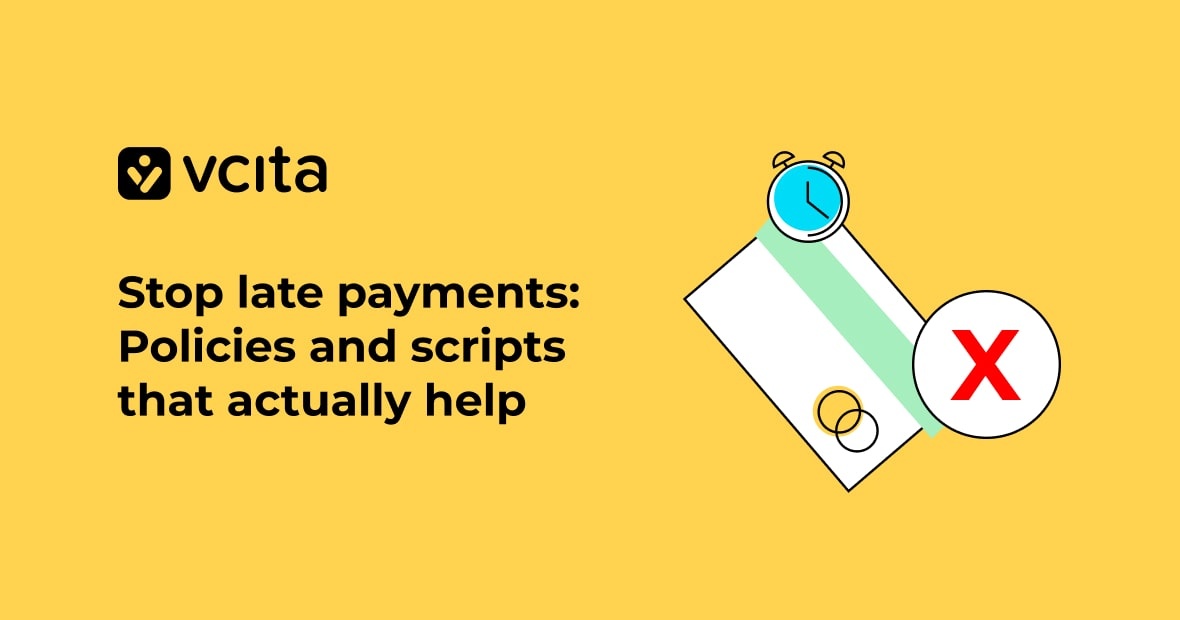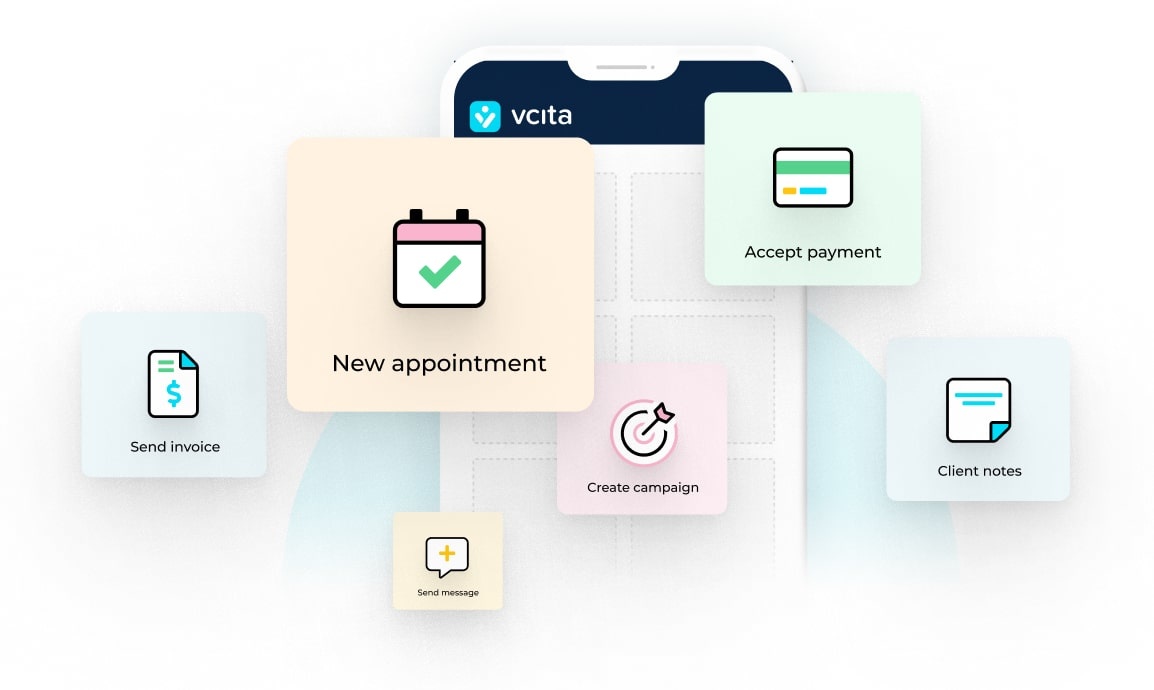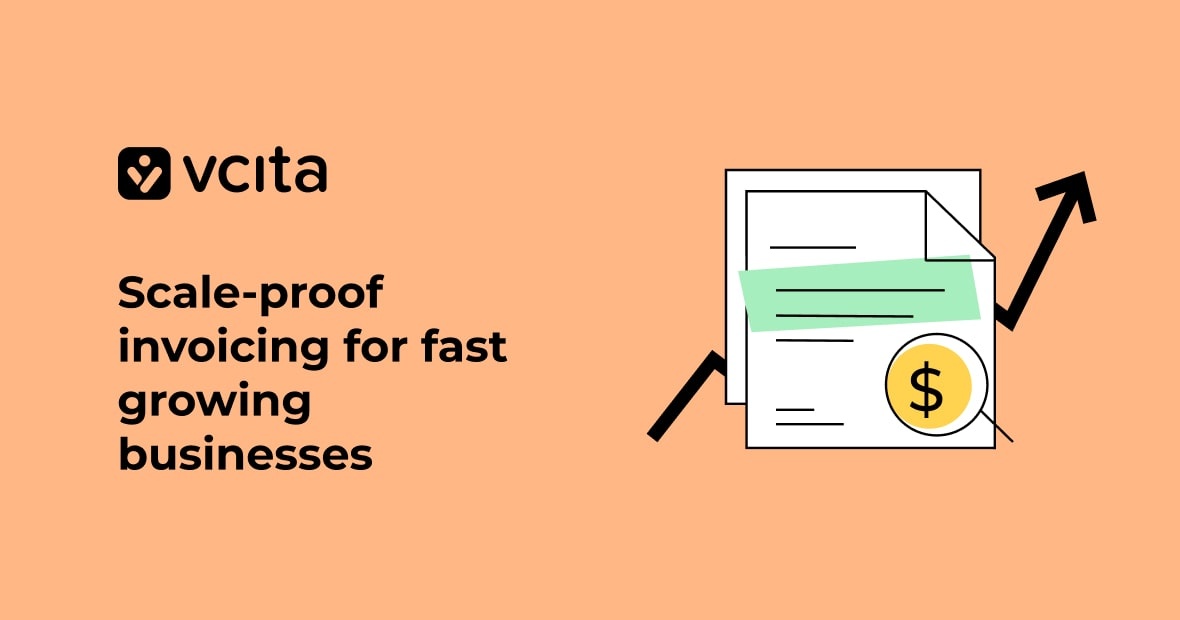Get AI insights on this blog post:
ChatGPT
Perplexity
You’re looking for a clean, low-stress way to collect payments? Here’s the short answer to your search : Set clear payment rules, ask for money earlier in the workflow, and automate the follow-up so you don’t have to chase people by hand. vcita makes this simple because it pulls scheduling, invoicing, and reminders into one place, and uses AI to help with wording, next steps, and record-keeping. You focus on the work, while the system nudges the client, tracks what’s due, and helps you get paid.
Key points
- Put your payment policy in writing and share it before you do the work.
- Use deposits or prepayment when it makes sense (e.g. first visit, high-no-show risk, or custom work).
- Send invoices that are simple, clear, and mobile-friendly.
- Automate reminders on a schedule that matches your terms.
- Escalate in stages: polite reminder → firm reminder → final notice → last-resort steps.
- Make it easy to pay, using an online checkout, saved details with your processor, and click-to-pay links.
- Track a few metrics like average days to pay, % overdue, and collected vs. billed.
- Use vcita to handle the flow end-to-end, with AI to draft messages, suggest next actions, and update your CRM.
TL;DR
The best way to prevent late payments is to set clear rules, take money upfront, and automate the rest. Build a simple policy, require deposits when needed, and use vcita to send invoices, payment links, and reminders automatically. When a payment is late, follow a short script that’s kind but firm. Keep everything in one system so nothing slips.
Your simple payment policy (copy, edit, use)
Keep your payment policy short. Post it on your booking page, invoices, and welcome email. It should include:
Payment terms
- Payment is due upon receipt unless noted on the invoice.
- We accept online payment by card or bank (via our secure checkout).
- For first-time bookings or custom work, a [30–50%] deposit is required to confirm.
Late payments
- 8 days late: service is paused until balance is paid.
- 15+ days late: future bookings will require full prepayment.
Cancellations and no-shows
- Please cancel or reschedule [24/48 hours] in advance.
- Missed or late cancellations may forfeit deposit.
- Packages and prepayments are non-refundable, but can be transferred to a future session within [X] days.
A short, plain policy like this sets expectations and gives you cover when you follow up.
Tip: requiring a deposit or prepayment is one of the simplest ways to reduce cancellations and speed up cash flow.
Workflows that reduce late payments (and save you time)
1) Collect earlier in the journey
- Request prepay at booking for popular or peak-time services.
- Require a deposit for long or custom work to cover your time and materials.
- Embed payment links in proposals or estimates, so clients can accept and pay in one move.
vcita supports all of these actions and ties them to the appointment or project. That means your calendar, client card, invoice, and payment all line up. You see what’s booked, what’s billed, and what’s still due in one view (no spreadsheet juggling). It also includes automatic reminders and an updated “Take payment” checkout flow for quick, POS-style charging when the client is in front of you.
2) Send better invoices
Your invoice should be crystal-clear, showing the service name, date, total, due date, how to pay, and contact info. Avoid long explanations and small print. vcita offers clean templates and invoice tracking so you can see sent, viewed, paid, and overdue invoices at a glance.
3) Automate reminders
Don’t rely on memory. Set a schedule. A simple pattern like this usually work:
- 1–2 days before due: gentle heads-up.
- On due date: quick reminder with link to pay.
- 3–5 days after due: firmer tone.
- 10–14 days after due: final notice and next steps.
vcita’s help center shows how to set payment reminders inside your billing screen.
4) Make payment easy
Clients pay faster when it’s simple. Use an online checkout, keep clicks to a minimum, and accept cards and other common payment methods. vcita provides hosted payment pages and links you can drop into emails, texts, and even your website, which supports the “no excuses” approach to fast payment.
5) Track the right numbers
Don’t measure everything. Watch these key metrics:
- Average days to pay (lower is better)
- Overdue rate (% of invoices late)
- Collected vs. billed (cash in vs. invoices out)
Tweak your reminder schedule and deposit rules based on these numbers. vcita’s invoice tracking posts cover the basics of keeping tabs on this.
Scripts you can use today
Friendly reminder (Email)
Subject: Quick reminder — Invoice #[Number] due [Date]
Hi [First name],
Hope you’re well. A quick nudge that invoice #[Number] for [Service] is due [Date].
You can pay here: [Secure payment link].
If you have any questions, just reply. Thanks so much.
— [Your name]
(vcita can generate and insert this link automatically and, with AI, draft a message in your tone so you don’t start from a blank page.)
First late notice (3–5 days past due)
Subject: Past due – Invoice #[Number]
Hi [First name],
I wanted to check in on invoice #[Number] for [Service], which shows as past due.
Please take care of it here: [Payment link].
If the timing is tight, tell me what works and we’ll sort a plan.
Thanks,
[Your name]
Second late notice (10–14 days past due)
Subject: Final reminder — Invoice #[Number]
Hi [First name],
This is a final reminder for invoice #[Number]. Per our policy, I’ll need to pause future work until the balance is cleared.
Please pay here: [Payment link].
If there’s an issue with the invoice, let me know today so I can help.
[Your name]
SMS nudge (very short)
“Hi [First name] — quick reminder: invoice #[Number] is due. Pay here: [short link]. Thanks! — [Your biz]”
(In vcita you can text from the client card, attach the link, and log the message automatically.)
Phone call opener
“Hi [First name], it’s [Your name]. I’m calling about invoice #[Number] for [Service]. Do you have a minute to take care of it now? I can send the link again if that’s easier.”
Keep it calm and factual. Don’t apologize for asking to be paid.
How vcita makes this easy (and why it’s my top pick)
You’re busy. You don’t want to have to switch between ten different tools to get paid for one job. vcita pulls your scheduling, client records, estimates, invoices, payments, reminders, email and SMS into one workflow. Here are the features that matter for smooth payment collection:
- Quick, clean invoices and estimates with a built-in “pay now” button.
- Payment links you can drop into email or SMS, or add to your website.
- Automated reminders based on your terms (before due, on due, and after).
- Deposits and prepayment at booking to cut no-shows and slow-pay.
- POS-style “Take payment” flow so you can charge on the spot from your service catalog (handy after an on-site job).
- Client portal so customers can view invoices, pay, and book without you jumping in.
- Tracking and dashboards for who owes what, what’s overdue, and what’s paid.
- AI assistance baked into the CRM:
- Compose quick, on-brand follow-ups.
- Suggest the next action when a message hints at payment (“Send reminder,” “Offer plan,” “Convert estimate to invoice”).
- Auto-fill client fields from recent conversations so your records stay clean.
- Propose the right call-to-action in tricky threads (“Send payment link,” “Request deposit,” “Offer reschedule with fee”).
The AI helps you move fast without sounding canned, and it learns from your tone. It won’t fix a broken process, but it will keep a good process humming.
Step-by-step: set up a late-payment-proof flow in vcita
- Write your policy (use the simple template above). Put it:
- On your booking page
- In your welcome email
- On every invoice footer
- Turn on deposits / prepayment for services that create the most risk (first-time clients, long sessions, custom work).
- Create invoice templates with your logo, clear line items, due date, and payment link.
- Set automated reminders:
- 2 days before due (gentle)
- On the due date (quick nudge)
- 3 days late (firm)
- 10 days late (final)
vcita’s help articles and templates can guide your message timing and content.
- Use AI to draft your reminders in your voice. Keep the first short and kind. Make the last one clear about next steps.
- Log SMS and calls from the client card, attach payment links, and keep all notes in one place.
- Review metrics monthly: days to pay, overdue rate, and top offenders. Adjust deposits or prepayment for the problem areas.
Handling edge cases
- A good client asks for more time. Offer a plan like half now, half in 7 days. Send two links and dates. Make it official in vcita so reminders match the plan.
- They dispute the invoice. Pause your reminders, fix the scope issue, then send a revised invoice immediately.
- They ghost you. Send the final notice, then stop new work and require full prepayment next time. If the amount is large and documented, consider a small-claims path or a collection service.
- Cash-flow crunch on your side. Consider earlier deposits, more prepayment, or smaller milestones billed after each service block. This lowers risk and smooths income.
Good wording principles (so clients don’t get defensive)
- Start with thanks: “Thanks again for coming in yesterday.”
- Be specific: invoice number, amount, due date, link.
- Be short: one or two small paragraphs.
- Be neutral: “shows as past due,” not “you didn’t pay.”
- Offer help: “If timing’s tight, tell me what works.”
- Set a boundary: pause work until paid, deposits for next booking, etc.
If you want a library of examples, vcita’s articles on reminder emails and payment policies are worth bookmarking.
FAQs
1) Should I charge a late fee?
Maybe. It can work, but the bigger win is to collect earlier (deposits, prepayment) and automate reminders. If you do add a fee, put it in your policy and on your invoices from day one.
2) What if a client wants to pay by check or cash?
Offer it, but still send a digital invoice and mark it paid in your system. Digital records keep your books clean and make taxes easier.
3) How many reminders are too many?
Two before and two after the due date is usually fine. Keep them short. Switch channels if needed (email → SMS → phone). vcita can automate most of this.
4) Is it okay to require prepayment?
Yes, especially for first-time clients or long bookings. Make it clear when they schedule. This prevents no-shows and disputes.
5) How do I phrase a “final notice”?
State the facts: amount, due date, link, and add the consequence (pause work until paid). Keep it respectful, not angry. The script above is a safe baseline.
6) What if I hate talking about money?
Let the system do it. Use vcita’s AI to draft reminders and put your policy in writing so you’re enforcing rules, not attacking anyone.
7) Can I offer payment plans?
Yes. Split invoices into milestones and set dates, then send separate links for each part. Document the plan and automate reminders for each due date.
8) How do I know if my process is working?
Watch your average days to pay and overdue rate metrics. If those numbers improve month over month, keep going. If not, tighten prepayment or shorten your terms.
Final thought
You don’t need a perfect script or a complex system. You need a clear policy, a simple way to pay, and a routine that runs without you. Put those pieces in place once, let vcita handle the nudges and logs, and you’ll spend more time on your work and less time chasing invoices.




























